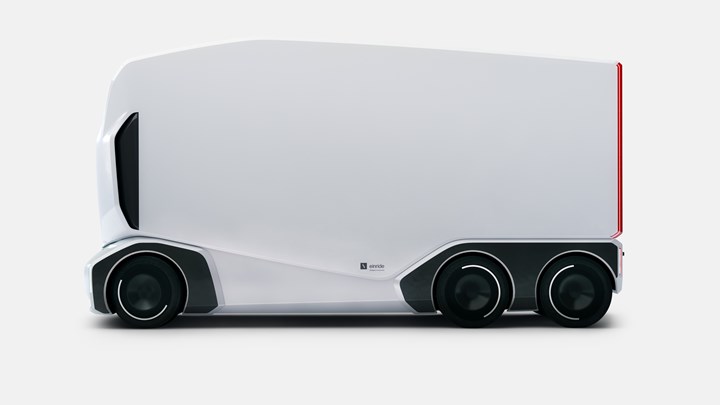Einride Reveals New Pods
Electric, autonomous transport vehicles for freight can be ordered right now
“Why didn’t you make a diesel truck? Everyone else is doing it.”
That is what Robert Falck, CEO and founder of Einride, said he’s often heard since 2016 when the Stockholm, Sweden-based company was founded.
“The transport industry uses 11 million barrels of oil a day,” he said, noting that it represents about 7% of global CO2 emissions.
“By choice, we decided to make something different.”

The Einride AET—Autonomous Electric Transport. (Images: Einride)
And so they developed the “Pod,” an “Autonomous Electric Transport” (AET) vehicle developed for commercial transport.
Falck admits that the Pod is not capable of doing everything that a standard truck can, but that it is applicable to performing the tasks done by from 20 to 30% being done in transport today.
Notably: with a solid business case for doing so.
According to Faulk, who was launching the new generation of Pods, which he said was redesigned with production requirements being taken into account, said that during the past four years the team at Einride weren’t just working on the Pod, but elements of a system that makes using it practical and economical to operate it.
These elements are:
- Freight operating system—Faulk said they’ve been working with customers to determine exactly what their shipping needs are: distances, types of goods, amount, etc.
- Electric fleet system——“When you do a diesel platform, it is literally a case of ‘Here are the keys.’ But if you try to do that with an electric vehicle that won’t get you so far,” Faulk said. So again, this is an issue of determining what is feasible. And he reiterated that he thinks 20 to 30% of all commercial transport today could be handled by electric vehicles—with existing batteries.
- Autonomous mobility system—Einride is taking a step-by-step approach in developing this capability. The AET 1 system is for fenced in areas with predetermined routes. AET 2 is for closed facilities and limited capabilities on public roads. AET 3 is for operations on rural roads where there is little traffic; it can operate at speeds up to 45 km/h ( ). And the AET 4 is for autonomous operation on freeways and other major roads; it can operate at up to 85 km/h.
Falck noted that legislation is one of the issues that has to be addressed in order to allow the trucks to operate on public roads. (Which is why present operations are AET 1, within closed facilities.)

No cab because this is an autonomous truck. And it is electric.
Among the launch partners that Einride is working with are Bridgestone and Northvolt.
The Pods are available for order via the Einride website. The AET 1 and 2 can be ordered now while reservations are available for the AET 3 and 4 with expected delivery in 2022-2023.
Reservations require an initial $1,500 and then an additional $8,500 invoiced after the reservation. This is a subscription-based approach that includes the fleet operating system to coordinate and operate the Pods with monitoring by Einride-certified remote operators. As such, there are operational fees for the vehicles, which are $18,000 per month for the AET 1, $19,000 per month for the AET 2, $20,000 per month for the AET 3 and $22,500 per month for the AET 4.
RELATED CONTENT
-
GM Is Down with Diesels
General Motors is one company that is clearly embracing the diesel engine.
-
Increasing Use of Structural Adhesives in Automotive
Can you glue a car together? Frank Billotto of DuPont Transportation & Industrial discusses the major role structural adhesives can play in vehicle assembly.
-
Jeeps Modified for Moab
On Easter morning in Moab, Utah, when the population of that exceedingly-hard-to-get-to town in one of the most beautiful settings on Earth has more than doubled, some people won’t be hunting for Easter eggs, but will be trying to get a good look at one of the vehicles six that Jeep has prepared for real-life, fast-feedback from the assembled at the annual Easter Jeep Safari.


.jpg;width=70;height=70;mode=crop)






